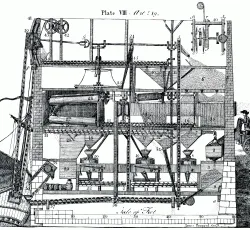George Washington studied and implemented improved farming methods throughout his life. In fact, he thought of himself first as a farmer.
George Washington devoted his life to the improvement of American agriculture.
While his initial interest in farming was driven by his own needs to earn a living and improve Mount Vernon, in later years Washington realized his leadership and experimentation could assist all American farmers.
Initially growing tobacco as his cash crop, Washington soon realized that tobacco was not sustainable and he switched to grains, particularly wheat as a cash crop in 1766. Washington read the latest works on agriculture and implemented the new husbandry methods using a variety of fertilization methods and crop rotation plans on his five farms.

George Washington and Agriculture
George Washington took an early interest in husbandry and agricultural improvement. Learn more about Washington’s desire to improve the state of American agriculture through careful experimentation.
Learn more
Field Labor
The majority of enslaved people at Mount Vernon were assigned to agricultural work on the plantation’s four outlying farms. Under the supervision of overseers, field hands toiled from sunrise to sunset, which could mean 14-hour days in the summer.
Learn more
Did George Washington Grow Hemp?
Dean Norton, Director of Horticulture uncovers the truth about George Washington and hemp.
Learn MoreA Day in the Life of an Enslaved Field Worker
"Every Labourer (male or female) does as much in the 24 hours as their strength without endangering the health, or constitution will allow of." - George Washington, 1789

Dairies at Mount Vernon
Learn about the history of dairying at Mount Vernon and Washington's desire to set an example for his countrymen.
Learn more

Maximizing Value and Efficiency
A series of savvy decisions kept Washington on the forefront of the American agricultural industry.
Learn more
Dogue Run Farm
Learn how George Washington worked to develop the Dogue Run Farm - one of the five farms at Mount Vernon - into one of his most productive fields.
Learn More
16-Sided Barn
Learn more about Washington’s remarkable and innovative 16-sided treading barn located on his Dogue Run farm.
Learn more
Map: Extent of Washington's 1793 Mount Vernon Land Holdings
This map shows the historic boundaries of George Washington's five farms at Mount Vernon superimposed over today's modern landscape. Much of this once-rural landscape remains free from development today.
See the Map

Washington as Bookkeeper
George Washington personally kept fastidious financial records throughout his life, an impressive feat considering the size of his business enterprise.
Learn more
The Animals of Mount Vernon
Learn more about the various heritage breed animals that we have here at Mount Vernon today - animals that Washington would have been familiar with.
Re-creating a Washington Farming Experiment

Mount Vernon staff get their hands dirty testing different soil mixtures—just as Washington did in 1760.
The Maharajah of Mules

Why does Rinker Buck, bestselling author of The Oregon Trail, call George Washington the "Maharajah of Mules?" Find out in this interesting interview.




































